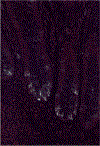Inflammatory Bowel Disease from the Perspective of Newer Innate Immune System Biomarkers
- PMID: 40129852
- PMCID: PMC11931671
- DOI: 10.3390/gidisord7010022
Inflammatory Bowel Disease from the Perspective of Newer Innate Immune System Biomarkers
Abstract
Background: The perspective of inflammatory bowel disease (IBD) has changed radically since the first decade of the 21st century, and the formerly monolithic components of IBD, ulcerative colitis (UC), and Crohn's disease (CD) have undergone a fundamental convergence, with realization that there is likely an element of shared pathogenesis. The ground shift began with genomic revelation but with the current emergence of the innate immune system (InImS) as a key player, allowing for improved understanding of the associations between the immune underpinnings of IBD.
Methods: Using unique ferritin/fecal p87 (FERAD) or using colonoscopic effluent as denominator (FEREFF) and other ratios to test this hypothesis, we prospectively enrolled 2185 patients with increased risk of colorectal cancer, of whom 31 had UC and 18 CD, with 2136 controls and brought to bear in a convenient measure for the InImS, the FERAD ratio. The FERAD, FEREFF, and NLR ratios have been shown to be effective measures of the InImS in COVID-19 and various cancers. p87 is expressed in gut Paneth cells known to modulate the microbiome by secretion of alpha-defensins, a natural antibiotic. Other related parameters were also evaluated.
Results: There was no significant difference between the FERAD ratio in UC and CD. However, differences between IBD entities and controls were substantial.
Conclusions: InImS settings in IBD are similar between CD and UC. p87 tissue immunohistochemistry (IHC) is also shared. Other InImS markers, such as the absolute neutrophil/lymphocyte ratio, are also confluent between the two IBD forms.
Keywords: Adnab-9 antibody; Crohn’s disease; FERAD ratio; Paneth cells; immunohistochemistry (IHC); inflammatory bowel diseases; innate immune system; p87.
Conflict of interest statement
Conflicts of Interest: The authors declare no conflict of interests.
Figures





Similar articles
-
In the SARS-CoV-2 Pandora Pandemic: Can the Stance of Premorbid Intestinal Innate Immune System as Measured by Fecal Adnab-9 Binding of p87:Blood Ferritin, Yielding the FERAD Ratio, Predict COVID-19 Susceptibility and Survival in a Prospective Population Database?Int J Mol Sci. 2023 Apr 19;24(8):7536. doi: 10.3390/ijms24087536. Int J Mol Sci. 2023. PMID: 37108697 Free PMC article.
-
A Practical Format to Organize Cancer Constellations Using Innate Immune System Biomarkers: Implications for Early Diagnosis and Prognostication.Int J Transl Med (Basel). 2024 Dec 6;4(4):726-739. doi: 10.3390/ijtm4040050. Int J Transl Med (Basel). 2024. PMID: 40129890 Free PMC article.
-
Two-Sample Mendelian Randomization Analysis Investigates Causal Associations Between Gut Microbial Genera and Inflammatory Bowel Disease, and Specificity Causal Associations in Ulcerative Colitis or Crohn's Disease.Front Immunol. 2022 Jul 4;13:921546. doi: 10.3389/fimmu.2022.921546. eCollection 2022. Front Immunol. 2022. PMID: 35860271 Free PMC article.
-
Fecal transplantation for treatment of inflammatory bowel disease.Cochrane Database Syst Rev. 2018 Nov 13;11(11):CD012774. doi: 10.1002/14651858.CD012774.pub2. Cochrane Database Syst Rev. 2018. Update in: Cochrane Database Syst Rev. 2023 Apr 25;4:CD012774. doi: 10.1002/14651858.CD012774.pub3. PMID: 30480772 Free PMC article. Updated.
-
From intestinal stem cells to inflammatory bowel diseases.World J Gastroenterol. 2011 Jul 21;17(27):3198-203. doi: 10.3748/wjg.v17.i27.3198. World J Gastroenterol. 2011. PMID: 21912468 Free PMC article. Review.
Cited by
-
Neutrophils and NETs in Pathophysiology and Treatment of Inflammatory Bowel Disease.Int J Mol Sci. 2025 Jul 23;26(15):7098. doi: 10.3390/ijms26157098. Int J Mol Sci. 2025. PMID: 40806230 Free PMC article. Review.
References
-
- Crohn BB; Ginsburg L; Oppenheimer GD. Regional ileitis, a pathological and clinical entity. JAMA 1932, 99, 1323–1329. - PubMed
-
- Lennard-Jones JE. Inflammatory bowel disease: Medical therapy revisited. Scand. J. Gastroenterol. Suppl. 1992, 192, 110–116. - PubMed
-
- Sartor RB. Current concepts of the etiology and pathogenesis of ulcerative colitis and Crohn’s disease. Gastroenterol. Clin. N. Am. 1995, 24, 475–507. - PubMed
Grants and funding
LinkOut - more resources
Full Text Sources
